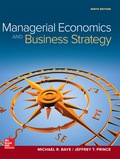
The four-firm concentration ratio is to be calculated.
Answer to Problem 1CACQ
Four-firm concentration ratio is 38%
Explanation of Solution
Given:
The total sales of all the 10 firms selling the product are $2000000.
The first four firm's sales are $260000, $220000, $150000 and $130000
The four-firm concentrationratio measures the proportion of sale of industry being done by top four firms. It shows market power in an industry.
Since, the first four firm's sales are $260000, $220000, $150000 and $130000, the four-firm concentration ratio is given by:
Hence, the four-firm concentration ratio in the market for product is 0.38 or 38%.
Introduction:
Theratio measures the proportion of sale of industry being done by top four firms. It shows market power in an industry.
Want to see more full solutions like this?
Chapter 7 Solutions
EBK MANAGERIAL ECONOMICS & BUSINESS STR
- How would you answer the question in the News Wire “Future Living Standards”? Why?arrow_forwardal Problems (v) T (ix) F 1. Out of total number of 2807 women, who were interviewed for employment in a textile factory, 912 were from textile areas and the rest from non-textile areas. Amongst the married women, who belonged to textile areas, 347 were having some work experience and 173 did not have work experience, while for non-textile areas the corresponding figures were 199 and 670 respectively. The total number of women having no experience was 1841 of whom 311 resided in textile areas. Of the total number of women, 1418 were unmarried and of these the number of women having experience in the textile and non-textile areas was 254 and 166 respectively. Tabulate the above information. [CA. (Foundation), May 2000 Exactly (14) of the total employees of a sugar mill were these were married and one-halfarrow_forwardHow did Jennifer Lopez use free enterprise to become successful ?arrow_forward
- An actuary analyzes a company’s annual personal auto claims, M and annual commercialauto claims, N . The analysis reveals that V ar(M ) = 1600, V ar(N ) = 900, and thecorrelation between M and N is ρ = 0.64. Compute V ar(M + N ).arrow_forwardDon't used hand raitingarrow_forwardAnswer in step by step with explanation. Don't use Ai.arrow_forward
- Use the figure below to answer the following question. Let I represent Income when healthy, let I represent income when ill. Let E [I] represent expected income for a given probability (p) of falling ill. Utility у в ULI income Is есте IM The actuarially fair & partial contract is represented by Point X × OB A Yarrow_forwardSuppose that there is a 25% chance Riju is injured and earns $180,000, and a 75% chance she stays healthy and will earn $900,000. Suppose further that her utility function is the following: U = (Income) ³. Riju's utility if she earns $180,000 is _ and her utility if she earns $900,000 is. X 56.46; 169.38 56.46; 96.55 96.55; 56.46 40.00; 200.00 169.38; 56.46arrow_forwardUse the figure below to answer the following question. Let là represent Income when healthy, let Is represent income when ill. Let E[I], represent expected income for a given probability (p) of falling ill. Utility & B естве IH S Point D represents ☑ actuarially fair & full contract actuarially fair & partial contract O actuarially unfair & full contract uninsurance incomearrow_forward
- Suppose that there is a 25% chance Riju is injured and earns $180,000, and a 75% chance she stays healthy and will earn $900,000. Suppose further that her utility function is the following: U = (Income). Riju is risk. She will prefer (given the same expected income). averse; no insurance to actuarially fair and full insurance lover; actuarially fair and full insurance to no insurance averse; actuarially fair and full insurance to no insurance neutral; he will be indifferent between actuarially fair and full insurance to no insurance lover; no insurance to actuarially fair and full insurancearrow_forward19. (20 points in total) Suppose that the market demand curve is p = 80 - 8Qd, where p is the price per unit and Qd is the number of units demanded per week, and the market supply curve is p = 5+7Qs, where Q5 is the quantity supplied per week. a. b. C. d. e. Calculate the equilibrium price and quantity for a competitive market in which there is no market failure. Draw a diagram that includes the demand and supply curves, the values of the vertical- axis intercepts, and the competitive equilibrium quantity and price. Label the curves, axes and areas. Calculate both the marginal willingness to pay and the total willingness to pay for the equilibrium quantity. Calculate both the marginal cost of the equilibrium quantity and variable cost of producing the equilibrium quantity. Calculate the total surplus. How is the value of total surplus related to your calculations in parts c and d?arrow_forwardPlease answer all parts of the questionarrow_forward
 Managerial Economics: Applications, Strategies an...EconomicsISBN:9781305506381Author:James R. McGuigan, R. Charles Moyer, Frederick H.deB. HarrisPublisher:Cengage Learning
Managerial Economics: Applications, Strategies an...EconomicsISBN:9781305506381Author:James R. McGuigan, R. Charles Moyer, Frederick H.deB. HarrisPublisher:Cengage Learning Economics (MindTap Course List)EconomicsISBN:9781337617383Author:Roger A. ArnoldPublisher:Cengage Learning
Economics (MindTap Course List)EconomicsISBN:9781337617383Author:Roger A. ArnoldPublisher:Cengage Learning








